IT sector electricity demand is expected to grow by 50 percent by 2030, reaching a total of 3,200TWh, according to a forecast that looks at the main – certain – IT technology developments and considers the progress and challenges on an electricity usage level.
As organizations accelerate their digital transformation and continue to digitize and people across the globe increase digital adoption in an ever more data-intensive and connected world, electricity usage from IT is expected to rise by 50% by 2030, a compound annual growth rate (CAGR) of 5 percent. However, as the electricity system decarbonizes, emissions would not increase by more than 26 percent by that time.
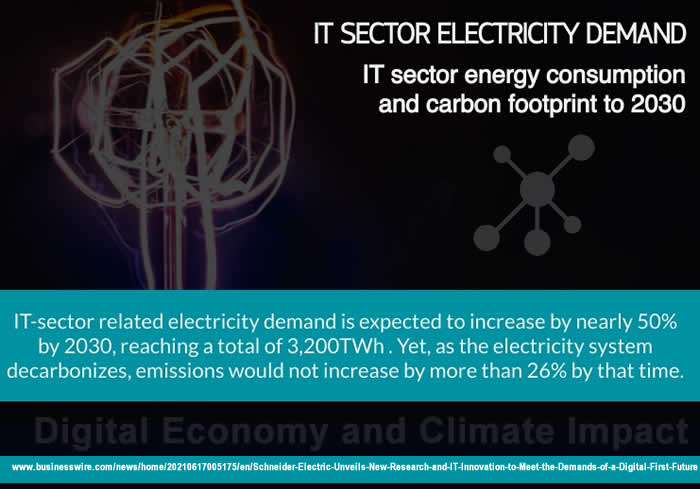
The fast-growing impact of IT on our lives and businesses, the continuous development of our big data world, and the more powerful technologies enabling us to build more connected and intelligent applications with IoT and AI aren’t new. Still, the impact of the COVID-19 pandemic and plans of governments to invest in a more digital, resilient, and sustainable future had and will have an acceleration effect.
Moreover, many organizations are still in the early stages of their digital transformation strategy, while in Industry 4.0, where IT integrates with OT (operational technology), tremendous efforts need to be made since cyber-physical convergence maturity is somewhat limited for now.
Because ongoing digitization and digital transformation boost IT sector electricity demand and energy requirements, there are clear concerns that this increasingly digital economy will have a negative impact on climate.
“IT electricity usage will rise by 50 percent by 2030. Yet this doesn’t have to lead to more CO2 emissions. With huge potential to decarbonize data centers, transport and buildings – digital is part of the solution (Philippe Delorme, Executive Vice-President, Energy Management, Schneider Electric)“
Yet, of course, one can’t simply forecast this impact without considering, among others, the evolutions in technology as such (with the shift to cloud and rise of edge computing being key), efforts on the level of decarbonization and sustainability, the addition of clean power sources, etc.
IT sector electricity demand: the need for more power in context
Simply saying that more IT by definition means a considerable increase in CO2 emissions, is incorrect.
Moreover, one has to look at the applications and technologies themselves. It’s clear that the increasing adoption of some technologies (and new applications built on top of them) has a different impact than others, whether it concerns Industry 4.0, enterprise IT, or more consumer-oriented applications.
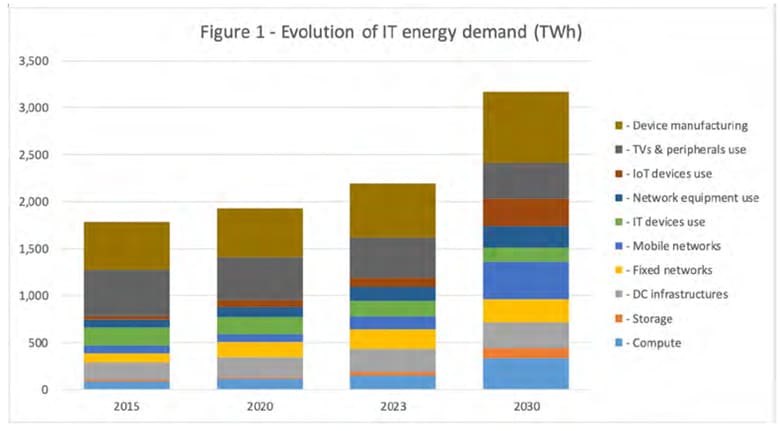
50 percent by 2030, reaching 3,200TWh, equivalent to 5 percent Compound
Annual Growth Rate (CAGR) over the next decade – evolution of IT energy demand in TWh
So, what can we expect, and how do we even forecast the impact of IT sector electricity going forward? And will it be that ‘bad’ as some predict? Organizations at the forefront of electrification, decarbonization, and digitization believe that the impact will be limited due to technological progress and clean power sources, combined with higher efficiency and more intelligent solutions.
Schneider Electric, a leader in the mentioned areas, released a report end May 2021, offering a refined forecast for IT electricity consumption up to 2030, along with the critical risks regarding the rise of IT in terms of electricity consumption.
In the report, entitled “Digital economy and climate impact. A bottom-up forecast of the IT sector energy consumption and carbon footprint to 2030,” – the authors estimate that IT sector electricity demand will grow by 50% by 2030, reaching 3,200TWh, as mentioned.
The forecast considers several observed efficiency gains in, among others, data centers, mobile network developments, and efficiencies realized in areas such as device manufacturing.
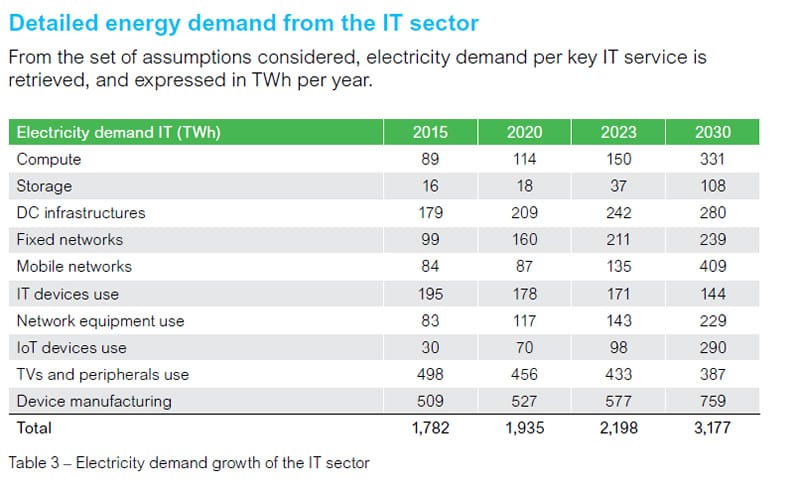
However, several emerging applications such as autonomous vehicles and blockchain developments are not considered in the forecast yet since the research focuses on the more “certain” technology developments, with the bulk of growth expected to come from data centers and networks.
The report uses a bottom-up approach based on two main sets of drivers for electricity demand growth from digitalization.
The forecasts, findings, and detailed data can be read per sector here, with the impact of digitalization on computing and data storage (“more data”, cfr. the growing datasphere) as the starting point.
Special attention will be required for edge computing as these systems are expected to be less efficient than hyperscale data centers from a PUE standpoint.
Computing and data storage is followed by the evolving data center landscape with the mentioned shift to cloud and rise of edge computing as inevitable topics, on top of new mobile networks and, of course, the connected world of IoT (Internet of Things) that is omnipresent in Schneider Electric’s business and solutions.
Per Schneider Electric, special attention will be required for edge computing as these systems are expected to be less efficient than hyperscale data centers from a PUE (power usage effectiveness) standpoint. Looking at edge spending forecasts, edge computing is a relatively fast growth area.
In an announcement of the report, Pankaj Sharma, EVP Secure Power at Schneider Electric, added that the analysis from the Schneider Electric Sustainability Institute puts to rest many of the worst-case scenario claims predicting IT-related electricity use will double every five years.
He emphasizes it’s misleading to assume that digital activity will inevitably result in a deeply problematic increase in CO2 emissions. Schneider Electric also announced a series of new solutions with features/capabilities that help leverage digital technologies, while taking into account sustainability and the need to reduce carbon footprint.
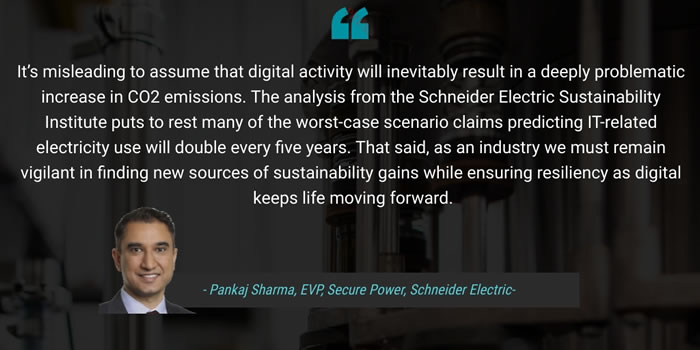
Similar solutions and strategic recommendations are also offered by other divisions of Schneider Electric since the increase of electricity usage and ever more data is ubiquitous. In an interview, the new global lead of the company’s EcoXpert partner program mentioned mass electrification and digitization of power and buildings as the key trend in building automation and energy management.
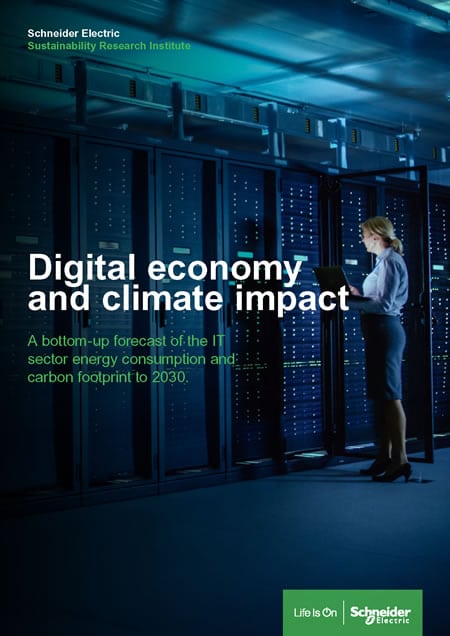
It affects the business and partners in all areas of this market, ranging from ‘building management systems‘ and ‘critical power‘ to panel builders and EcoXpert business partners with vertical specializations in, among others, healthcare facilities, retail facilities, and life sciences to mention a few.
The future is digital and electrical. Despite the results found in the report keeping an eye on evolutions will be key. As a company that wants to be zero carbon soon and is in the center of technologies for the sustainability agenda, Schneider Electric of course knows this and monitors the market closely to innovate.
Pankaj Sharma: “When the world locked down it also logged on and internet traffic soared…that said, as an industry we must remain vigilant in finding new sources of sustainability gains while ensuring resiliency as digital keeps life moving forward.”

